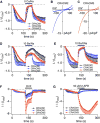CRACM1, CRACM2, and CRACM3 are store-operated Ca2+ channels with distinct functional properties
- PMID: 17442569
- PMCID: PMC5663639
- DOI: 10.1016/j.cub.2007.03.065
CRACM1, CRACM2, and CRACM3 are store-operated Ca2+ channels with distinct functional properties
Abstract
STIM1 in the endoplasmic reticulum and CRACM1 in the plasma membrane are essential molecular components for controlling the store-operated CRAC current. CRACM1 proteins multimerize and bind STIM1, and the combined overexpression of STIM1 and CRACM1 reconstitutes amplified CRAC currents. Mutations in CRACM1 determine the selectivity of CRAC currents, demonstrating that CRACM1 forms the CRAC channel's ion-selective pore, but the CRACM1 homologs CRACM2 and CRACM3 are less well characterized. Here, we show that both CRACM2 and CRACM3, when overexpressed in HEK293 cells stably expressing STIM1, potentiate I(CRAC) to current amplitudes 15-20 times larger than native I(CRAC). A nonconducting mutation of CRACM1 (E106Q) acts as a dominant negative for all three CRACM homologs, suggesting that they can form heteromultimeric channel complexes. All three CRACM homologs exhibit distinct properties in terms of selectivity for Ca(2+) and Na(+), differential pharmacological effects in response to 2-APB, and strikingly different feedback regulation by intracellular Ca(2+). Each of the CRAC channel proteins' specific functional features and the potential heteromerization provide for flexibility in shaping Ca(2+) signals, and their characteristic biophysical and pharmacological properties will aid in identifying CRAC-channel species in native cells that express them.
Figures




References
-
- Feske S, Gwack Y, Prakriya M, Srikanth S, Puppel SH, Tanasa B, Hogan PG, Lewis RS, Daly M, Rao A. A mutation in Orai1 causes immune deficiency by abrogating CRAC channel function. Nature. 2006;441:179–185. - PubMed
Publication types
MeSH terms
Substances
Grants and funding
LinkOut - more resources
Full Text Sources
Other Literature Sources
Molecular Biology Databases
Miscellaneous

